国标等级英语1A第一单元教案
新标准大学英语第一册1单元A篇教案
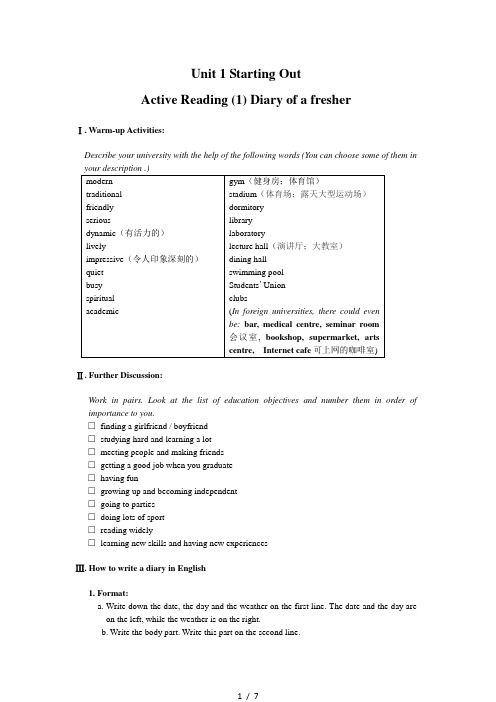
Unit 1 Starting OutActive Reading (1) Diary of a fresherⅠ. Warm-up Activities:Describe your university with the help of the following words (You can choose some of them inⅡ. Further Discussion:Work in pairs. Look at the list of education objectives and number them in order of importance to you.☐finding a girlfriend / boyfriend☐studying hard and learning a lot☐meeting people and making friends☐getting a good job when you graduate☐having fun☐growing up and becoming independent☐going to parties☐doing lots of sport☐reading widely☐learning new skills and having new experiencesⅢ. How to write a diary in English1. Format:a. Write down the date, the day and the weather on the first line. The date and the day areon the left, while the weather is on the right.b. Write the body part. Write this part on the second line.2. Person:Write the diary in the first person.3. Tense:a. Past tense;b. Present tense;c. Future tense.4. Order:Write the diary in chronological order.5. Style:Casual and informal: express a personal viewpoint with reactions, reflections and feelings.Ⅳ. Background Information & Culture Notes:1. A hall of residence(AmE dormitory): is a place where students live, often a large building,or a series of buildings with accommodation and some social facilities.2. A coffee morning: refers to an informational gathering with coffee, where people with acommon interest meet for an hour or so and get to know each other better.3. A gap year:is a year usually between finishing school and starting university or collegewhen you travel or work.4. A fresher’s fair: is an event when all the university clubs and societies try to attract newmembers.5.Ballroom dancing: is a type of dancing done by a man and a woman together, often in a6.Artificial intelligence(人工智能):is the ability of a machine to perform those activitiesthat are normally thought to require intelligence.Artificial intelligence Society:is a club for members who share the same interest in artificial intelligence.7.Bell ringing: is a musical activity which involves a group of six to ten people. Each personhas two bells, one in each hand and take turns to ring them. Each bell has a different musical mote, so the whole group can make musical melodies and harmonies.8.Extreme sports: (also known as "lifestyle sports" or "action sport") are a general term forsports featuring speed, height, danger or spectacular stunts. The sports have rooted in 1960s and have been growing since the late 1980s.bungee jumping rock climbing bull fighting free diving9.Choir is an organized company of singers, especially one performing church music orsinging in a church.Mozart Choir is a club for singer s to perform Mozart’s music.Ⅴ. Words & Expressions:1.gap: n.①a period of time between two events间隔,间断a gap in the conversation 谈话的间隙他们阔别20年后又见面了。
新标准大学英语视听说教程第一册第一单元教案

Unit 1 Starting outI.Time Allotment6 periodsII.Teaching Objectives and Requirements1.Develop the Ss’awareness of involving of talking about their college andcollege life;2.Ask Ss to remember useful words and expressions;3.Strengthen Ss’ ability to listen for the specific information;4.Provide Ss some information about how to hold an informal discussion. III.Teaching Proceduresi.Starting pointsTeaching tips1.Before Ss start, establish a clear signal to ask Ss to stop and go back to theirseats.2.Remind Ss to ask questions or give comments politely to find the informationand to make a quick note of other people’s names.Teaching steps1.As Ss to talk to at least 5 others from all areas of the room to find the information.2.Encourage Ss to use a variety of questions and comments, for example, about theprovince:Yes, I’m from Sichuan, too. I wonder how many other people we will meet from Sichuan.Well, I’m from Hubei. I haven’t met anyone from my province yet.3.Walk around to listen and encourage conversations. Help any Ss who seemuncertain or shy.4.After 4 to 5 minutes check whether most of the Ss have collected the information.It is not necessary for all Ss to have all the information.5.Go over the activity with the whole class. For each item, choose one or two Ss totalk about the information. Give conversational comments, for example, Really?That’s interesting. I suppose that is unusual or I think that might be a common experience, don’t you?ii.Inside ViewConversation 1Teaching steps1.Ask Ss to note down short answers while they watch.2.Check the answers by asking one or two Ss what they have written.3.Share some of the cultural information about Hertford University.Language and Culture1.Hertford College was founded in 1740. It is one of the 38 colleges of OxfordUniversity. (The merger of Green College and Templeton College in 2008 has reduced the number of official Oxford colleges from 30 to 38.) It is made up of three quads which are joined by a pedestrian bridge (seen in Conversation 1) called the Bridge of Sighs, after a similar bridge in Venice. Former students include the poet, John Donne, the philosopher, Thomas Hobbes, the satirist and writer, Jonathan Swift, and the novelist, Evelyn Waugh. It was one of the first Oxford colleges to admit women.2.Staircase 6, Room 5 shows tat the building is quite large and complActivity3.Sharing a room refers to two or more people living in one bedroom. In Britain,students may share university accommodation but they more often have their own bedrooms and share the bathroom and the kitchen.Conversation 2Activity 5 Teaching tipsAs a different way to check the answers, ask two Ss to perform a role-play. Ask one to introduce herself as Janet and the other as Kate. The pair uses the information from their completed tables while other Ss check their answers.Activity 6 Teaching tips1.Give Ss time to look quickly through the written dialogue before playingConversation 2 again.2.To check the answers, ask two Ss to read out the complete dialogue. Encouragethem to read with meaning.Conversation 3Teaching tipsMake sure Ss appreciate how alternative answers are possible for predictions. Teaching steps1.Tell Ss this is a prediction task and make sure they understand what this means.2.Ask Ss to discuss the five items in pairs.3.Choose five pairs to give their answers to the class. Student A gives the predictedquestions and Student B gives the answers.4.Play Conversations 3 for Ss to check their answers.Language and cultureStudents and some staff eat in the dining hall. This may also happen in other universities but more often there is a snack bar, caféor restaurant. Staff may eat separately in a senior common room. Ss are often in self-catering accommodation so they cook for themselves and eat in a small kitchen.Everyday EnglishTeaching steps1.Ask Ss to work in pairs and choose (a) or (b) according to the meaning of thephrase in the context of the conversation.2.Go over the answers by reading the complete sentences.Talking pointsTeaching steps1.Choose one proverb as an example and explain briefly to the class what it means.Perhaps add a personal reason why you think it is important or why you like it. 2.As k Ss to read through all the proverbs in pairs and take turns to explain what theproverbs mean to each other.3.During the discussion time, walk around the classroom and listen to Ss. Offer helpif there are any difficulties.4.After the discussion time, ask Ss to choose their favorite proverbs from thosegiven.5.Choose several Ss to tell the class which is their favorite proverb, what it meansand why they particularly like it.6.Ask other Ss if they have any additional comments and share more comments ofyour own.iii.Outside viewTeaching tipsTo go through the answers, ask Ss to work in pairs. Student a reads the completed sentence and then Student B asks a conversational question to follow up the statement, then A and B exchange roles for the nest sentence, and so on. Examples of possible conversational questions are given below. Use some of these to demonstrate the idea of conversational questions to the class.Language and culture1.Studying modern languages normally means that students study two languages,probably chosen among French, German, Spanish, Italian, sometimes with Portuguese, Dutch, Swedish or Eastern European languages. “Modern” is distinct from “classics”(Latin and Greek) and, usually, from ‘Oriental”languages (Chinese, Japanese, Korean, etc.)2.Conservative is a general term to describe social pr political attitudes in whichpeople are not willing to accept much change, especially in eh traditional values fo society or to support the preservative of a nation or culture.3.Liberal is a social or political philosophy or attitude which shows openness to newideas about progress or reform and change if most people want it.iv.Listening inTeaching tips1.Ask Ss to read through the sentences quickly before listening to the passage.2.Encourage Ss to explain why the other answers are not the best.v.Presentation skillsLanguage support1. A key / specialized / normal / multi-disciplinary university2.section --- department --- faculty3.shared accommodation in dormitories on campus4.English corner5.places where we can relax / hang out / have fun / study together6.Campus life is largely self-oriented.7.student societies and clubs --- organize sports / social events8.study hard and relax well / a good work-life balancevi.Pronunciationvii.Unit tasks。
一级 unit 1 教案
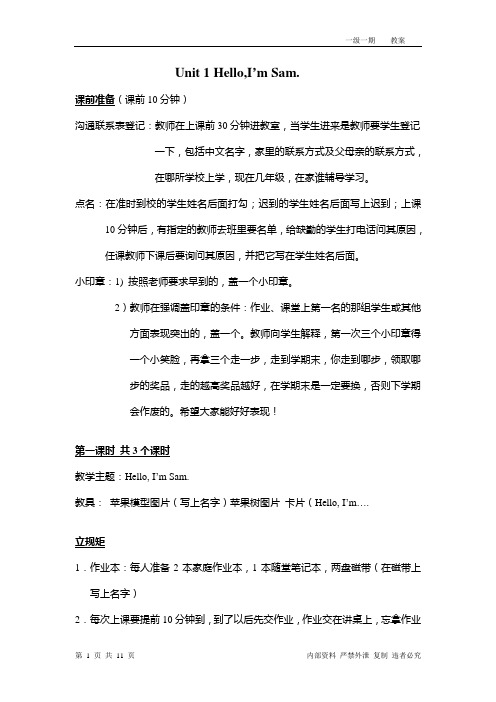
Unit 1 Hello,I’m Sam.课前准备(课前10分钟)沟通联系表登记:教师在上课前30分钟进教室,当学生进来是教师要学生登记一下,包括中文名字,家里的联系方式及父母亲的联系方式,在哪所学校上学,现在几年级,在家谁辅导学习。
点名:在准时到校的学生姓名后面打勾;迟到的学生姓名后面写上迟到;上课10分钟后,有指定的教师去班里要名单,给缺勤的学生打电话问其原因,任课教师下课后要询问其原因,并把它写在学生姓名后面。
小印章:1) 按照老师要求早到的,盖一个小印章。
2)教师在强调盖印章的条件:作业、课堂上第一名的那组学生或其他方面表现突出的,盖一个。
教师向学生解释,第一次三个小印章得一个小笑脸,再拿三个走一步,走到学期末,你走到哪步,领取哪步的奖品,走的越高奖品越好,在学期末是一定要换,否则下学期会作废的。
希望大家能好好表现!第一课时共3个课时教学主题:Hello, I’m Sam.教具:苹果模型图片(写上名字)苹果树图片卡片(Hello, I’m….立规矩1.作业本:每人准备2本家庭作业本,1本随堂笔记本,两盘磁带(在磁带上写上名字)2.每次上课要提前10分钟到,到了以后先交作业,作业交在讲桌上,忘拿作业的同学打电话让家长下课前稍来,交了作业的盖一个小印章。
3.上课规矩:1)上课不允许学生下位或老师没说自己站起来的,第一次警告,第二次扣分。
2)教师让回答问题时起举手回答,不许大声喧哗,回答问题的学生请站起来回答问题,否则扣组1分。
有问题的学生请举手问问题。
表现好的组加分。
3)学生上来做对话时,其他需学生必须认真听讲,如发现在此期间说话的或干别的事的学生扣组1分。
那组表现好加分。
4)教师让学生写单词或句型,写时必须用白板笔写,写完的必须坐在原位举手等老师过去看,表现好的组加分。
5.下课休息规矩:下课后要排队出教室,不可在楼道大声喧哗,否则扣组1分。
谁表现好给盖一个小印章。
6.下学:1) 下学后要清理自己桌子的垃圾,拿好自己的东西,不要随地乱扔,把垃圾扔进垃圾桶里。
小学英语教案:《牛津》1A Unit 1教学设计
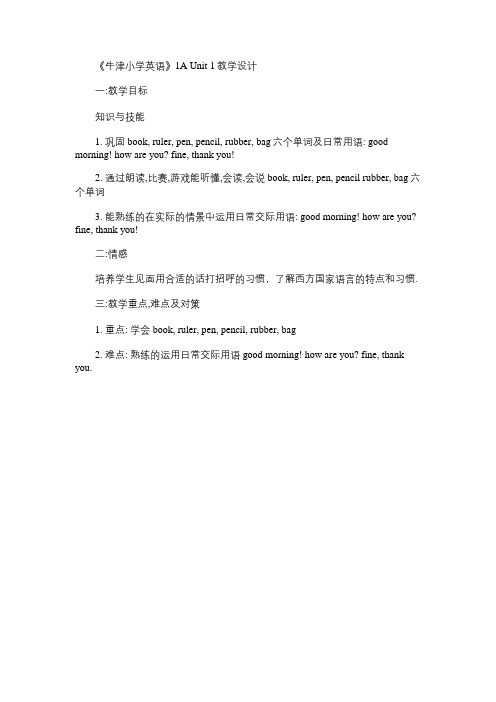
《牛津小学英语》1A Unit 1教学设计一:教学目标知识与技能1. 巩固 book, ruler, pen, pencil, rubber, bag六个单词及日常用语: good morning! how are you? fine, thank you!2. 通过朗读,比赛,游戏能听懂,会读,会说book, ruler, pen, pencil rubber, bag六个单词3. 能熟练的在实际的情景中运用日常交际用语: good morning! how are you? fine, thank you!二:情感培养学生见面用合适的话打招呼的习惯,了解西方国家语言的特点和习惯.三:教学重点,难点及对策1. 重点: 学会 book, ruler, pen, pencil, rubber, bag2. 难点: 熟练的运用日常交际用语good morning! how are you? fine, thank you.3.教学对策: 表演询问法, 情景交际法, 直观教学法.四:教学过程step one: warning exercises1. greetingt: class begins! s: stand up!t: hello, class! ss: hello, miss kong!2.do the actionstand up, please! sit down, please!open your book! close your book!step two: presentation ( learn to read )1: teacher shows the pictures to the students, say the words: book, ruler, pen, pencil, rubber, bag.2: teacher says the word ‘book’,ask the students to hold up their rulers and repeat the word together. the same way to practice all the words.3: teacher asks the students to match the words and the pictures.step three: presentation ( learn to say )1: 利用布偶或玩具将这句话演示出来,让学生感知 good morning的发音及意义.2: 老师依次用 good morning 和学生打招呼.3: 让学生和老师打招呼,再让学生分组互相打招呼4: 顺水推舟,用good morning引出 how are you ? fine, thank you.5: 师生,生生情景操练:t: good morning! ss: good morning!t: how are you? ss: fine, thank you!6: 玩游戏:“找朋友”学生围成一圈随音乐拍手,两位学生在圈中走动找朋友,音乐一停,圈内学生必须与各自朋友互相问好 good morning, how are you? fine, thank you!然后继续找朋友.。
新课标高中英语1必修全册教案

新课标高中英语1必修全册教案一、教学内容1. Unit 1 My First Day at Senior High详细内容:描述了学生在高中的第一天,通过对话和阅读了解校园生活。
2. Unit 2 My New Teachers详细内容:介绍了几位不同风格的老师,学习如何描述人物特点。
二、教学目标1. 掌握本单元的重点词汇和短语,并能灵活运用到实际情景中。
2. 提高学生的听说读写能力,尤其是描述人物和事件的能力。
3. 培养学生学会尊重和理解不同的教学风格,增强团队合作意识。
三、教学难点与重点1. 教学难点:描述人物特点的词汇和句型,以及如何运用到实际情景中。
2. 教学重点:听说读写技能的培养,尤其是口语表达能力的提高。
四、教具与学具准备1. 教具:多媒体设备、PPT、黑板、录音机、卡片等。
2. 学具:课本、练习本、字典、笔等。
五、教学过程1. 导入:通过展示一组学生在高中第一天的照片,引发学生讨论,导入新课。
2. 新课内容展示:讲解Unit 1 My First Day at Senior High 的重点词汇和句型,进行角色扮演活动。
3. 例题讲解:针对Unit 2 My New Teachers,讲解如何描述人物特点,给出示例。
4. 随堂练习:让学生运用所学知识,描述自己的老师,进行小组讨论。
5. 口语练习:模拟情景,让学生进行对话练习,提高口语表达能力。
六、板书设计1. Unit 1 My First Day at Senior High重点词汇:nervous, excited, confused, helpful, friendly等。
重点句型:I felt when; The teacher is and he/she等。
2. Unit 2 My New Teachers描述人物特点的词汇:strict, patient, humorous, knowledgeable等。
描述人物特点的句型:My teacher is; He/She always等。
新标准大学英语1教案

课时:2课时教学目标:1. 让学生理解课文主旨,掌握文章结构。
2. 培养学生的阅读技巧,包括文本评估、略读和扫读。
3. 扩大学生的词汇量,特别是关于食物的词汇。
4. 让学生熟悉表达个人情感的方法。
5. 利用课文中的表达方式和语法点,提高学生的写作和认知能力。
教学重点:1. 课文主旨和大意。
2. 阅读技巧:文本评估、略读和扫读。
3. 食物相关词汇的掌握。
4. 个人情感表达。
5. 课文中的表达方式和语法点的运用。
教学难点:1. 阅读技巧的灵活运用。
2. 食物相关词汇的扩展。
3. 个人情感表达的准确性。
教学准备:1. 课文教材:《新标准大学英语1》Unit 2 Food, glorious food。
2. 多媒体课件。
3. 食物相关图片和视频资料。
教学过程:第一课时一、导入1. 利用多媒体展示与食物相关的图片和视频,激发学生学习兴趣。
2. 引导学生谈论自己熟悉的食物,为学习课文做好铺垫。
二、课文学习1. 学生自读课文,了解文章大意。
2. 教师引导学生分析课文结构,包括段落大意和文章主旨。
3. 教师讲解课文中的重点词汇和短语,如:delicious, appetizing, fast food, gourmet, etc.4. 学生练习翻译课文中的重点句子。
三、阅读技巧训练1. 教师讲解文本评估、略读和扫读的技巧。
2. 学生进行相关练习,提高阅读速度和理解能力。
四、课堂小结1. 回顾本节课所学内容,强调重点。
2. 布置课后作业。
第二课时一、复习导入1. 回顾上节课所学内容,检查学生对课文的理解程度。
2. 引导学生谈论自己课后作业的完成情况。
二、词汇拓展1. 教师讲解与食物相关的词汇,如:dish, cuisine, snack, delicacy, etc.2. 学生练习使用这些词汇造句。
三、角色扮演1. 教师将学生分成小组,每组选取一个关于食物的故事进行角色扮演。
2. 学生在角色扮演中运用所学词汇和语法点。
英语考级一级教案范文模板

教学对象:小学一年级学生教学目标:1. 知识目标:学生能够掌握并运用日常生活中的基本英语表达,如问候、道别、请求帮助等。
2. 能力目标:通过情景模拟和角色扮演,提高学生的听说能力。
3. 情感目标:培养学生对英语学习的兴趣,增强自信心。
教学重点:1. 日常英语表达的正确发音和拼写。
2. 基本句型的正确运用。
教学难点:1. 不同语境下英语表达的灵活性。
2. 学生在真实情境中的英语运用能力。
教学准备:1. 教学课件或图片,用于展示日常英语表达。
2. 情景模拟道具,如小卡片、玩具等。
3. 录音设备,用于播放英语发音示范。
教学过程:一、导入1. 教师通过自我介绍,用英语问候学生,激发学生学习兴趣。
2. 学生用英语回答教师的问候,复习已学英语。
二、新课教授1. 教师展示日常英语表达图片或课件,如“Hello, Good morning!”、“Goodbye, See you later!”等。
2. 教师示范发音,并引导学生跟读。
3. 教师讲解重点句型,如“Can you help me, please?”、“What’s your name?”等。
4. 学生分组练习,教师巡视指导。
三、情景模拟1. 教师设计几个日常生活场景,如购物、问路、打招呼等。
2. 学生分组进行角色扮演,运用所学英语进行交流。
3. 教师点评并给予指导。
四、巩固练习1. 教师播放录音,学生跟读。
2. 学生分组进行听写练习,巩固所学知识。
五、总结1. 教师总结本节课所学内容,强调重点和难点。
2. 学生分享学习心得,提出疑问。
六、作业布置1. 学生回家后,与家长用英语进行简单对话,如问候、道别等。
2. 学生模仿情景模拟中的角色扮演,巩固所学知识。
教学反思:本节课通过图片、情景模拟等方式,让学生在轻松愉快的氛围中学习日常英语表达。
在教学过程中,应注意以下几点:1. 注重学生的发音练习,确保学生能够准确发音。
2. 鼓励学生在真实情境中运用所学英语,提高学生的英语实际运用能力。
英语考级一级教案模板范文
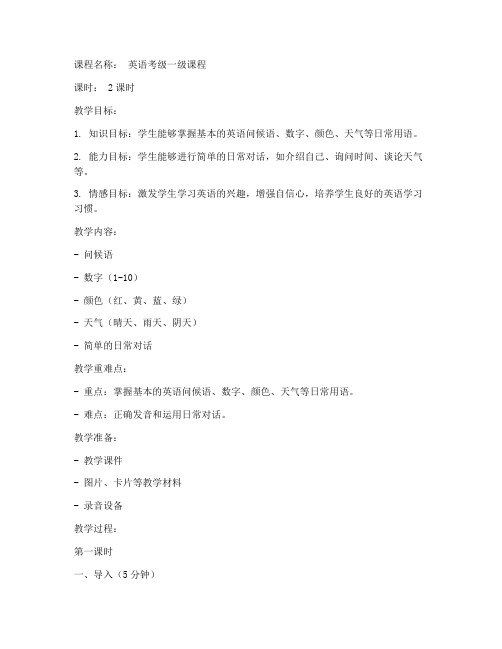
课程名称:英语考级一级课程课时: 2课时教学目标:1. 知识目标:学生能够掌握基本的英语问候语、数字、颜色、天气等日常用语。
2. 能力目标:学生能够进行简单的日常对话,如介绍自己、询问时间、谈论天气等。
3. 情感目标:激发学生学习英语的兴趣,增强自信心,培养学生良好的英语学习习惯。
教学内容:- 问候语- 数字(1-10)- 颜色(红、黄、蓝、绿)- 天气(晴天、雨天、阴天)- 简单的日常对话教学重难点:- 重点:掌握基本的英语问候语、数字、颜色、天气等日常用语。
- 难点:正确发音和运用日常对话。
教学准备:- 教学课件- 图片、卡片等教学材料- 录音设备教学过程:第一课时一、导入(5分钟)1. 教师播放英语歌曲《Hello! Hello!》营造轻松的学习氛围。
2. 学生跟随歌曲做动作,活跃课堂气氛。
二、新课教学(25分钟)1. 教师展示图片,引导学生说出图片中的物品名称。
2. 引入问候语,如“Hello! Good morning! How are you?”等,并带领学生练习。
3. 教师展示数字卡片,引导学生说出数字1-10,并进行简单的数字游戏。
4. 教师展示颜色卡片,引导学生说出颜色单词,并进行颜色匹配游戏。
5. 教师展示天气图片,引导学生说出天气单词,如“sunny, rainy, cloudy”等。
三、巩固练习(10分钟)1. 教师播放录音,学生跟读。
2. 学生分组进行角色扮演,练习日常对话。
四、总结(5分钟)1. 教师总结本节课所学内容。
2. 学生分享自己的学习心得。
第二课时一、复习(5分钟)1. 教师提问,检查学生对上节课内容的掌握情况。
2. 学生进行小组讨论,复习所学知识。
二、新课教学(25分钟)1. 教师展示日常对话场景,如上学、购物、问路等。
2. 教师引导学生运用所学词汇和句型进行对话。
3. 教师播放录音,学生跟读,并尝试模仿对话。
三、巩固练习(10分钟)1. 学生进行小组合作,完成日常对话练习。
1A Unit 1牛津英语1A教案
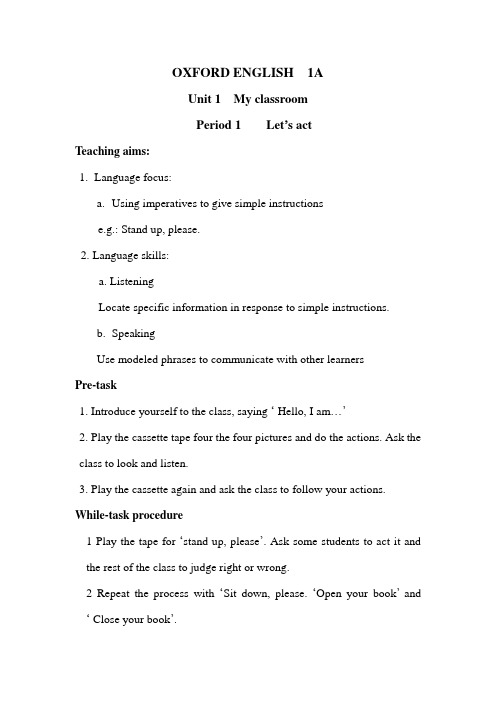
OXFORD ENGLISH 1AUnit 1 My classroomPeriod 1 Let’s actTeaching aims:nguage focus:ing imperatives to give simple instructionse.g.: Stand up, please.2. Language skills:a. ListeningLocate specific information in response to simple instructions.b.SpeakingUse modeled phrases to communicate with other learnersPre-task1. Introduce yourself to the class, saying … Hello, I am…‟2. Play the cassette tape four the four pictures and do the actions. Ask the class to look and listen.3. Play the cassette again and ask the class to follow your actions. While-task procedure1 Play the tape for …stand up, please‟. Ask some students to act it and the rest of the class to judge right or wrong.2 Repeat the process with …Sit down, please. …Open your book‟and … Close your book‟.3 Open the students‟ Book to page 2 and read the commands for the class to follow , or play the cassette tape. Ask the students to point to the relevant pictures with their figures.4 Give commands and ask individual students to repeat and act them. Post –task activities1 Repeat the commands and ask the students to act them.3. Play the cassette again and ask the class to follow your actions.2 Divide the students into pairs. One student gives commands and the other student acts. Then let them change roles.二次备:1、Introduction“Hello, I am…”,学生”Hello, I am….”2、 A song <<Hello Hello Hello>>相互问好3、Instruct students using “Stand up. Sit down.”Open your book. Close your book.老师发出指令,学生学做。
Unit1(SectionA3a-3c)(教案)
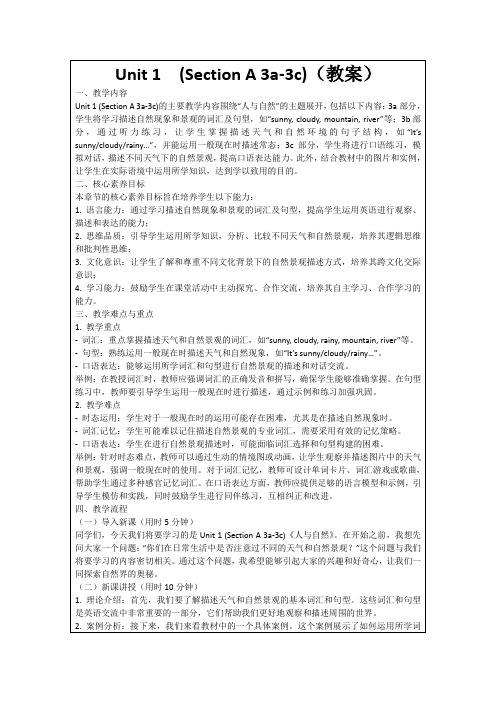
(四)学生小组讨论(用时10分钟)
1.讨论主题:学生将围绕“描述自然景观在实际生活中的应用”这一主题展开讨论。
2.引导与启发:在讨论过程中,我将提出一些开放性问题,帮助学生发现和解决问题,鼓励他们提出自己的观点。
3.成果分享:每个小组将分享他们的讨论成果,这些成果将被记录在黑板上或投影仪上。
-词汇记忆:学生可能难以记住描述自然景观的专业词汇,需要采用有效的记忆策略。
-口语表达:学生在进行自然景观描述时,可能面临词汇选择和句型构建的困难。
举例:针对时态难点,教师可以通过生动的情境图或动画,让学生观察并描述图片中的天气和景观,强调一般现在时的使用。对于词汇记忆,教师可设计单词卡片、词汇游戏或歌曲,帮助学生通过多种感官记忆词汇。在口语表达方面,教师应提供足够的语言模型和示例,引导学生模仿和实践,同时鼓励学生进行同ቤተ መጻሕፍቲ ባይዱ练习,互相纠正和改进。
(五)总结回顾(用时5分钟)
今天的学习,我们了解了描述天气和自然景观的词汇和句型,并通过实践活动和小组讨论加深了对这些知识点的理解。我希望大家能够掌握并运用这些知识点,在日常生活中更好地观察和描述自然。如果有任何疑问,请随时向我提问。
五、教学反思
在今天的教学过程中,我发现学生们对于描述天气和自然景观的词汇和句型表现出浓厚的兴趣。他们积极参与到课堂讨论和角色扮演活动中,这让我感到很欣慰。然而,我也注意到一些问题,值得我们共同反思。
(二)新课讲授(用时10分钟)
1.理论介绍:首先,我们要了解描述天气和自然景观的基本词汇和句型。这些词汇和句型是英语交流中非常重要的一部分,它们帮助我们更好地观察和描述周围的世界。
2.案例分析:接下来,我们来看教材中的一个具体案例。这个案例展示了如何运用所学词汇和句型描述自然景观,以及它们在实际交流中的应用。
英语考级一级教案模板范文

一、教学目标1. 知识目标:掌握一级英语考级的基本词汇和句型,能够进行简单的日常交流。
2. 能力目标:提高学生的听、说、读、写能力,培养良好的英语学习习惯。
3. 情感目标:激发学生学习英语的兴趣,增强自信心,树立正确的学习态度。
二、教学内容1. 单元主题:家庭、学校、天气等日常生活话题。
2. 词汇:hello, goodbye, thank you, please, sorry, yes, no, my name is..., what's your name?, I'm...years old, nice to meet you, this is..., that is..., how old are you?, I like..., I don't like..., I have..., I don't have...等。
3. 句型:How are you? I'm fine, thank you. And you? What's your name? My name is..., What's this? It's a...What's that? It's a...等。
三、教学重难点1. 重点:掌握基本词汇和句型,能够进行简单的日常交流。
2. 难点:正确发音、拼写单词,以及句子结构的运用。
四、教学过程1. 导入新课(1)播放一首英语歌曲,活跃课堂气氛,激发学生学习兴趣。
(2)教师用英语与学生进行简单的互动,如问候、介绍自己等。
2. 新课学习(1)词汇学习:教师带领学生学习新词汇,并进行发音、拼写练习。
(2)句型学习:教师讲解句型结构,并进行实际应用练习。
3. 课堂活动(1)角色扮演:教师将学生分成小组,进行角色扮演活动,如询问姓名、年龄、喜好等。
(2)单词接龙:学生依次说出一个单词,下一个学生需以该单词的最后一个字母开头,说出另一个单词。
小学一年级英语 1Aunit1教案
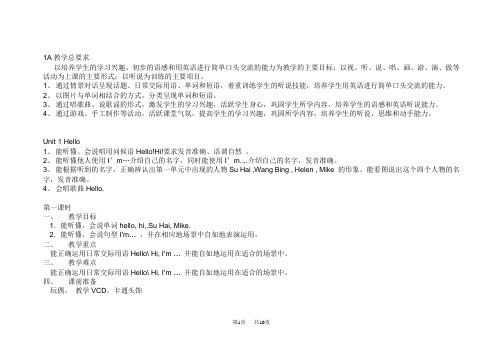
1A教学总要求以培养学生的学习兴趣、初步的语感和用英语进行简单口头交流的能力为教学的主要目标;以视、听、说、唱、画、游、演、做等活动为上课的主要形式;以听说为训练的主要项目。
1、通过情景对话呈现话题、日常交际用语、单词和短语,着重训练学生的听说技能,培养学生用英语进行简单口头交流的能力。
2、以图片与单词相结合的方式,分类呈现单词和短语。
3、通过唱歌曲、说歌谣的形式,激发学生的学习兴趣,活跃学生身心,巩固学生所学内容,培养学生的语感和英语听说能力。
4、通过游戏、手工制作等活动,活跃课堂气氛,提高学生的学习兴趣,巩固所学内容,培养学生的听说、思维和动手能力。
Unit 1 Hello1、能听懂、会说唱用问候语Hello!Hi!要求发音准确、语调自然。
2、能听懂他人使用I’m…介绍自己的名字,同时能使用I’m..,.介绍自己的名字,发音准确。
3、能根据听到的名字,正确辨认出第一单元中出现的人物Su Hai ,Wang Bing , Helen , Mike 的形象。
能看图说出这个四个人物的名字,发音准确。
4、会唱歌曲Hello.第一课时一、教学目标1. 能听懂,会说单词hello, hi,.Su Hai, Mike.2. 能听懂,会说句型I’m…,并在相应地场景中自如地表演运用。
二、教学重点能正确运用日常交际用语Hello\ Hi, I’m …并能自如地运用在适合的场景中。
三、教学难点能正确运用日常交际用语Hello\ Hi, I’m …并能自如地运用在适合的场景中。
四、课前准备玩偶,教学VCD,卡通头饰第1页共10页五、教学过程Step 1Free talk Step 2 PresentationStep3 Learn to say T: Class begins.T: Hello, boys and girls.1. T: Hello, I’m Miss Li. What’syour name?(可用中文稍做解释,帮助学生听懂)引导学生用I’m……回答T: Oh, you’re … Nice to meetyou.2. T:(拿出2个木偶)Look, they aremy good friends.(模仿小木偶的口气表演) Hello, I’mWeiwei.Hello,I’m Dongdong.T: Let’s speak English with Weiweiand Dongdong, OK?1. T: When we meet someone, weshould say “Hello/ Hi “Now,let’s watch and listen. (播放课文对话)。
公共英语公共英语1级教案
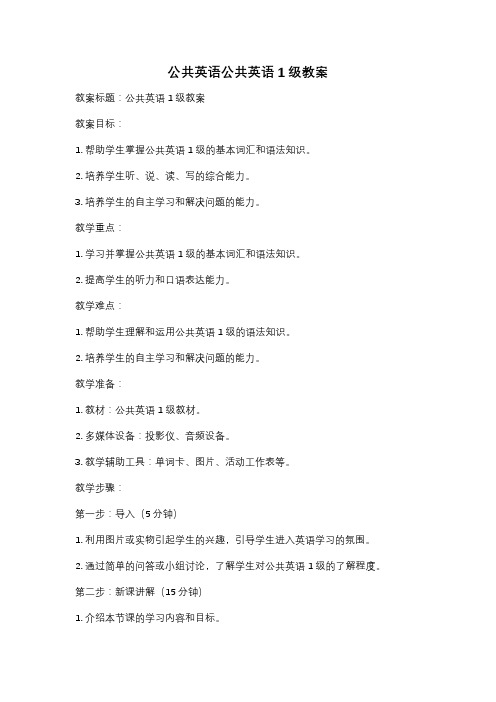
公共英语公共英语1级教案教案标题:公共英语1级教案教案目标:1. 帮助学生掌握公共英语1级的基本词汇和语法知识。
2. 培养学生听、说、读、写的综合能力。
3. 培养学生的自主学习和解决问题的能力。
教学重点:1. 学习并掌握公共英语1级的基本词汇和语法知识。
2. 提高学生的听力和口语表达能力。
教学难点:1. 帮助学生理解和运用公共英语1级的语法知识。
2. 培养学生的自主学习和解决问题的能力。
教学准备:1. 教材:公共英语1级教材。
2. 多媒体设备:投影仪、音频设备。
3. 教学辅助工具:单词卡、图片、活动工作表等。
教学步骤:第一步:导入(5分钟)1. 利用图片或实物引起学生的兴趣,引导学生进入英语学习的氛围。
2. 通过简单的问答或小组讨论,了解学生对公共英语1级的了解程度。
第二步:新课讲解(15分钟)1. 介绍本节课的学习内容和目标。
2. 利用多媒体展示教材中的相关课文和例句,让学生对新词汇和语法有初步了解。
3. 解释和讲解新词汇的发音、词义和用法。
4. 通过示范和练习,帮助学生理解和掌握新的语法知识。
第三步:听说训练(20分钟)1. 播放教材中的听力材料,让学生进行听力训练。
2. 针对听力内容,设计相关的口语练习,让学生进行对话练习,提高口语表达能力。
第四步:阅读训练(15分钟)1. 选择教材中的相关阅读材料,让学生进行阅读训练。
2. 引导学生理解文章的主旨和关键信息,并进行相关的问题讨论。
第五步:写作训练(15分钟)1. 设计与教材内容相关的写作任务,如写一篇简短的日记、写一封信等。
2. 引导学生根据所学知识和词汇进行写作,并提供必要的写作指导和反馈。
第六步:巩固与拓展(10分钟)1. 设计一些小组活动或游戏,巩固学生所学的知识和技能。
2. 鼓励学生自主学习和解决问题,提供必要的指导和帮助。
第七步:作业布置(5分钟)1. 布置与本节课内容相关的作业,如完成课后习题、预习下节课等。
2. 强调作业的重要性,并提供必要的指导和解答。
新标准英语1册教案新部编本Module1Unit1
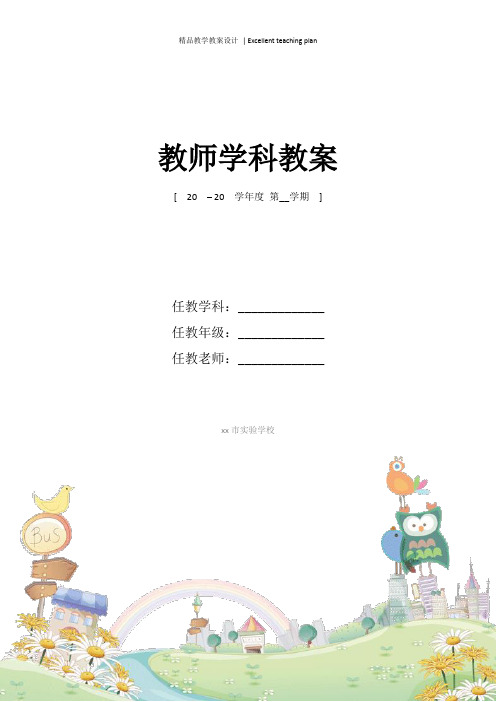
F:Bye,Baobao.
Activity 3:Practise Everyday English.
1)Hello!/Hi!
2)I`m Tingting./I`m Taotao.
3)Goodbye!/Bye!
Activity book:Finish the relative exercises.
Help them have a sense of learning and saying English.
Speaking.
More exercises more fluently.
Outline the entire knowledge and have them remember clearly.
Do the exercises in the activity book.
Arouse their interest in learning English.
Outstand the key points of knowledge.
Create a favorable atmosphere for learning.
Get some information about the new lesson.
Master the core contents.
Listen the tape and cultivate their listening abilities.
Put the words in practice.
Repeat using them and say them smoothly.
学习方法
Cooperate with each otheቤተ መጻሕፍቲ ባይዱ and compare among groups.
- 1、下载文档前请自行甄别文档内容的完整性,平台不提供额外的编辑、内容补充、找答案等附加服务。
- 2、"仅部分预览"的文档,不可在线预览部分如存在完整性等问题,可反馈申请退款(可完整预览的文档不适用该条件!)。
- 3、如文档侵犯您的权益,请联系客服反馈,我们会尽快为您处理(人工客服工作时间:9:00-18:30)。
Lesson 1 Hello!第一课时教学内容:TALK & LOOK AND COLOUR教学目标:使学生认识书中的四个主人公,并与之交朋友能理解会话内容,并运用里面的主题句型自如交流教学重点:重点句型Hi! / hello!What’s your name? My name is … / I’m …教学难点:句型What’s your name? My name is …培养学生自如交流的能力课前准备:VCD光盘、单词卡片、主人公手偶或头饰教学步骤及建议:I. Greeting & Warming up本节课为新学期第一节课,所以老师要做自我介绍,并与学生相互认识。
老师面带微笑,与学生亲切问好:Hi! / Hello! My name is … / I’m …请学生模仿老师与老师打招呼。
老师到学生中间与学生互动。
可加入小游戏:I say “Hi!” You say “Hello!”做快速反应练习,进一步拉近师生之间的距离。
学生熟悉打招呼用语之后,可加入小chant:Hello, hello! Hi, hi!Hello, hello! Hi, hi!Hello, hello, hello! Hi!Hello, hello! Hi, hi, hi!老师带领学生边说边做动作,可适当变换语速来增加趣味感。
II. Presentation & Drills1. 熟悉四个主人公,并与之交朋友。
1) 老师可拿出四个主人公的图片或将其做成指偶或手偶。
增加一些神秘气息,逐个出示人物,老师模仿主人公做自我介绍(Hello, I’m … / My name is …),请学生与主人公打招呼或握手拥抱。
老师可将每一个主人公编一个TPR动作教给学生。
规定哪个动作代表哪个人物。
2) 学生熟悉主人公之后,老师再带领学生进行强化记忆。
可拿图片进行快速反应,老师出示人物图片,学生说出人物的名字;或者老师做动作,学生说出名字。
2. 学习句型。
新句型:What’s your name? My name is … / I’m …1) 老师先示范: “My name is … What ’s your name?” 注意示范的时候语速要慢一点,让学生听清楚句子当中的每一个单词,老师可适当重复,并把句子写在黑板上。
请学生模仿老师说句子 “My name is …” 老师可采用竞争机制调动学生的积极性,如看哪位学生的声音最大,说的最好,给予奖励。
建议采用“总-分-总”的顺序来进行。
2) 学生会说“My name is …”句子之后,老师请学生回忆一下是怎么问的,由此引出问句“What ’s your name?”。
然后将句子板书并适当操练。
进行问答练习。
可师生之间问答,也可让学生相互问答。
建议教学活动:“问答接力”或“抛球问答”3) 利用主人公手偶引出句子“I’m …”。
老师拿手偶与学生互动,进行问答练习。
老师模仿手偶回答“I’m …”,之后问学生手偶是怎么回答的,将句型“I’m …”板书并适当操练。
老师稍作解释介绍自己用“My name is …”或者“I ’m …”都可以。
4) 带领学生将句型What ’s your name? My name is … / I’m …进行适当操练。
3. 呈现对话。
播放VCD 光盘,请学生看一遍。
之后请学生说出里面的人物都谈了些什么。
再播放一遍光盘并跟读。
老师可将句型编成TPR 带学生边做边说。
III. Consolidation1. 分组分角色朗读或表演对话。
2. 请学生上前表演对话。
老师需提前准备道具,如头饰等。
IV. Summary1. 总结本课重点句型。
可以以师生问答的形式进行。
2. 总结本课的四个主人公。
先让学生来回忆,之后出示图片或手偶。
分别与四个主人公道别。
V. Homework1. 看光盘,并跟着光盘朗读或表演对话。
2. 用学过的句型跟爸爸妈妈进行交流。
教学流程第二课时教学内容:LISTEN, PLAY & SING教学目标:1. 通过本节课的练习与巩固活动,使学生能够准确输出所学句型并能熟练应用2. 会唱并表演歌曲What ’s your name?教学重点:对句型的复习与巩固歌曲What ’s your name?课前准备:VCD 光盘、做手工用的材料(乒乓球两个、裁纸刀、彩笔)教学步骤及建议:I. Greeting & Warming up1. 师生相互问好。
2. 一起表演上节课学过的Chant :Hello, hello! Hi, hi!Hello, hello! Hi, hi!Hello, hello, hello, hi!Hello, hello! Hi, hi, hi!II. Revision1. 复习上节课学过的句型,可以以师生问答的方式进行。
2. 带领学生大声朗读TALK 中的对话。
3. 找学生上前角色表演。
III. Presentation & Drills本节课主要为对上节课所学内容的复习和巩固。
老师可以通过教材中的LISTEN 板块先对学生进行听力练习的训练。
之后再通过PLAY 部分的活动对所学内容进行巩固和输出。
1. LISTNE 部分1) Listen and match带领学生先熟悉里面的句型,之后老师播放录音请学生根据录音将相匹配的句型连在一起。
连完之后找几名学生说出他们听到的结果,之后老师说出准确答案。
最后分别找三组学生分别读每一组句型。
2) Listen and trace小低的学生对颜色敏感度较高,本版块的设计意图为通过涂颜色复习所学知识点。
老师先给学生讲清楚这部分的规则:男孩说的话框涂成绿色,女孩说的话框涂成红色。
请学生边听边涂颜色。
之后请学生两人一组进行对话。
2. PLAY 部分1) Make and act本部分为手工制作,着眼于九项技能(听说读写唱画演玩做)中的“做”。
培养孩子的动手能力,并且能够复习知识点。
操作流程:(1) 准备两个黄色乒乓球(2) 将两个球体的底部切掉三分之一部分(3) 在球的表面画上Dick和Lucky的头像(4) 将拇指插入球的底部,进行角色扮演。
可以请学生来比赛,看哪个学生做的最好。
2) Make and talk本题也是需要学生动手制作如图中的类似于扇子的道具,然后相互进行自我介绍,让学生在玩一玩中轻松掌握所学句型。
3. SING1) 先带领学生熟悉一遍歌曲中的句型。
2) 播放VCD光盘,请学生欣赏歌曲。
3) 老师将歌曲中句子的动作教给学生,之后带学生边唱边做。
4) 师生一起跟VCD光盘边唱边做动作。
5) 请学生将歌曲中的名字替换成自己的名字唱出来。
6) 师生互动。
老师唱每一段的前一句,请学生用自己的名字唱后一句。
7) 请学生带头饰表演歌曲。
(需课前准备四个主人公的头饰)IV. Summary总结本课主要句型。
Hello! / Hi!What’s your name? My name is … / I’m …VI. Homework1. 将手工制作拿回家,并表演给爸爸妈妈看。
2. 将歌曲唱给爸爸妈妈听。
教学流程第三课时教学内容:READ教学目标:1.能认识字母Aa 到Nn 的音和形,准确认读字母2. 能将大小写字母正确匹配3. 能按顺序背诵字母4. 能按正确的笔画和格式书写字母教学重点:字母的认读及书写课前准备:字母卡片教学步骤及建议:I. Greeting & Warming up1. 师生相互问好2. 表演歌曲What ’s your name?II. Revision复习本课的主要句型,可以以师生问答的方式进行。
推荐游戏:问答接龙。
III. Presentation & Drills本节课的主要内容为26个字母的认读及书写,相对其它的教学内容稍显单调。
为避免枯燥,老师需带领学生在游戏活动中学习操练及巩固。
1. 将一些可以用缩略语表示的常见事物出示给学生,请学生说出其缩略语。
如: VCD, DVD, IC 卡, MP3, KFC, NBA, KTV , QQ, MSN, LG, SHE …2. 请学生说出这些缩略语都是由什么组成的。
引出“英文字母”这个概念。
3. 引导学生将缩略语中的字母按顺序摘出来,再进行板书。
如:NBA – Aa Bb KFC – Cc DVD – Dd SHE – Ee KFC – Ff LG – Gg SHE – Hh IC 卡 – Ii KTV – Kk LG – Ll MP3 – Mm NBA – Nn4. 请学生听录音并模仿模仿是学习的第一步,也是保证学生能够正确发音的关键。
此部分老师尽量让学生跟录音模仿,以保证最纯的发音。
模仿完之后找个别学生读字母,老师找出学生发音不准确的地方并予以纠正。
5. 认读字母老师通过一些教学活动及教具带领学生认识字母的形。
推荐活动:1) 造型字母请学生准备珠子或豆粒等物品。
老师说出一个字母,请学生用最快的速度摆出该字母的形状。
2) 闪卡老师迅速出示字母卡片,请学生抢读字母。
3) 点名老师将字母卡片分给学生每人一张,卡片上的字母即为学生的代号。
然后由教师发令,如:Aa。
则持有字母Aa的学生立即站起来说:Here I am. 等学生适应后,老师加快点名的速度。
出错者将被淘汰,坚持到最后者为优胜。
4) 字母操老师带领学生用自己的身体摆成字母的形状。
和学生一起边表演边说字母。
6. 字母书写书写教学一开始就要严格要求,培养学生良好的书写习惯。
老师在讲解时应注意让学生认真观察字母的笔顺与占格,然后再让学生模仿和操练,还要注意将检查和评价相结合,检查学生的书写是否按照字母的笔顺和字母在四线格中应占的位置书写,字母的大小,宽窄是否协调和谐,间隔是否均匀,适当,培养学生正确的书写习惯,包括写字的姿势,放纸的位置等。
IV. Consolidation请学生大声朗读一遍字母。
唱英文字母歌。
注意准确发音。
V. Summary总结发音较难的字母,强化记忆。
如:Cc, Gg, Hh, Jj, Ll ...VI. Homework1. 听录音,跟读字母。
2. 抄写字母,注意格式和笔顺。
3. 搜集缩略语,并写下来。
教学流程。
